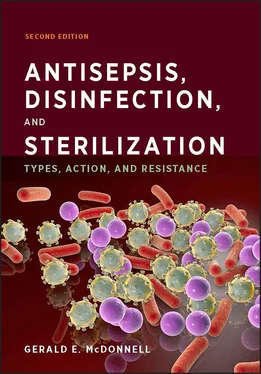Biocidal processes include many physical and chemical methods. Physical processes include heat (e.g., steam) and radiation (e.g., UV radiation). A wide range of chemicals, such as aldehydes, halogens, and phenolics, are also used due to their antimicrobial activities. The choice and use of a biocide will depend on the required application. For example, many aggressive chemicals or high-temperature processes can be used on various hard surfaces, like medical devices, but would not be acceptable for use as antiseptics on the skin. Therefore, there are three primary considerations in the choice of a biocide: antimicrobial efficacy, safety, and compatibility. There is no perfect biocide for any application, but the desired attributes include the following:
Activity against a wide range of (if not all) microorganisms
Rapid activity
Efficacy in the presence of contaminating organic and inorganic materials, which can inhibit the activity of the biocide
Low or no toxicity, irritancy, mutagenicity (causing genetic mutations), or carcinogenicity (causing cancer)
Safe use
Lack of damage to surfaces or areas (compatibility)
Lack of unwanted or toxic residues
Stability, yet ability to be readily broken down in the environment
Environmental friendliness
It is clear that the advantages and disadvantages of each biocide should be considered in deciding its suitability in a given application.
This book describes the major antiseptic, disinfectant, and sterilization practices that are used. For the purpose of introduction, this chapter gives a brief description of the various types of target microorganisms, as well as a discussion of some key considerations for biocidal applications, including the evaluation of efficacy, formulation effects, and the importance of cleaning. Chapters 2and 3describe the various types of physical and chemical biocides and biocidal processes, including filtration, which is not a true biocidal process but is widely used in the disinfection and sterilization of liquids and gases. For each biocide group, the various types, applications, spectra of antimicrobial activities, advantages, and disadvantages and a brief discussion of the mode of action are given. Chapter 4addresses the use of biocides as antiseptics and antiseptic applications. Chapters 5and 6discuss various types of physical and chemical sterilization methods, which are considered distinct from disinfection applications. Chapter 7addresses the current understanding of the mechanisms of biocidal action on microorganisms. In most cases, the modes of action of biocides are quite distinct from the more specific anti-infective agents, like antibiotics. Biocide mechanisms are considered in four general groups with similar mechanisms of action, including oxidizing agents, cross-linking agents, action by transfer of energy, and other structure-disrupting agents. Finally, chapter 8introduces the growing concern about microbial resistance to biocides. This topic has been particularly well studied in bacteria, and a discussion of the various intrinsic and acquired mechanisms of resistance is provided. Further, descriptions of specific mechanisms of resistance in viruses, prions, and fungi and other eukaryotes are also given.
In considering biocidal applications, definitions can vary widely. The following terms and their definitions, where possible, are consistent with international consensus documents.
Aerobe (adj., aerobic): An organism that grows in the presence of oxygen. Can be obligate (requiring oxygen), facultative (able to grow in the presence or absence of oxygen), or microaerophilic (requiring a lower concentration of oxygen than is present in air).
Anaerobe (adj., anaerobic): An organism that grows in the absence of oxygen. Can be obligate (requiring the absence of oxygen) or facultative (able to grow in the presence or absence of oxygen).
Antibiotic: A substance (or drug) that kills or inhibits the growth of bacteria. This definition has also been applied to substances that affect other microorganisms, in particular, fungi. Originally, antibiotics were discovered as substances that were produced by one type of microorganism (in particular, fungi) which selectively inhibited the growth of other microorganisms (in particular, bacteria). Many antibiotics are now synthetically produced.
Anti-infective: A substance (or drug) capable of killing microorganisms or inhibiting their growth, in particular, pathogenic microorganisms. This term is used to encompass drugs that specifically act on certain microbial types, including antibacterials (antibiotics), antifungals, antivirals, and antiprotozoal agents. For the purpose of discussion, the term anti-infectives will be used to described drugs that are used to treat specific infections within animals, plants, and humans. This is in contrast to biocides or biocidal processes, which are considered to be broad-spectrum antimicrobials that are used on inanimate surfaces or the skin and mucous membranes. The differentiation between anti-infectives and biocides is considered further in section 7.1.
Antimicrobial: A process or product that is effective at killing microorganisms. This can vary, depending on the process or product and the target microorganism (e.g., antibacterial or antifungal). Antimicrobial agents include physical and chemical methods.
Antisepsis (noun and adj., antiseptic): Destruction or inhibition of microorganisms in or on living tissue, e.g., on the skin. An antiseptic is a biocidal product used on the skin.
Aseptic (noun, asepsis): Free of, or using methods to keep free of, microorganisms.
Aseptic processing: The act of handling materials in a controlled environment in which the air supply, materials, equipment, and personnel are regulated to control microbial and particulate contamination within acceptable levels.
Bioburden: The microbial load, or numbers and types of microorganisms, with which an item (surface or product) is contaminated.
Biocide: A chemical or physical agent, usually with a broad spectrum of activity, that inactivates microorganisms. Chemical biocides include hydrogen peroxide and phenols, while physical biocides include heat and radiation. Biocides are generally broad spectrum, in contrast to anti-infectives, which have a narrower range of antimicrobial activity (see section 7.1).
Biofilm: A community of microorganisms (either single or multiple species) developed on or associated with a surface.
-Cidal: Suffix indicating lethal activity against a group of microorganisms (e.g., sporicidal means having activity to kill bacterial spores, and bactericidal means having the ability to kill bacteria). Compare to -static.
Cleaning: Removal of contamination (often referred to as “soil”) from a surface to the extent necessary for further processing or for the intended use.
Decontamination: Physical and/or chemical means to render a surface or item safe for handling, use, or disposal. Decontamination can refer to either chemical and biological removal or inactivation, with emphasis on biological decontamination. Decontamination is generally a combination of cleaning and disinfection or sterilization.
Deinfestation: Removal or destruction of macroorganisms (e.g., insects).
Disinfection (noun, disinfectant): The antimicrobial reduction of the number of viable microorganisms, or bioburden, on or in a product or surface to a level previously specified as appropriate for its intended further handling or use. In general, disinfection is used to describe a product (a disinfectant) or process that is effective against most pathogens, with the exception of bacterial spores, which are considered the organisms most resistant to disinfection and sterilization. Disinfectants are often subdivided into high level, intermediate, and low level (depending on the product claims and registrations). High-level disinfectants are considered effective against most microbial pathogens, with the exception of large numbers of bacterial spores. These products are usually sporicidal over longer exposure times. Intermediate-level disinfectants are effective against mycobacteria, vegetative bacteria, most viruses, and fungi, but not necessarily bacterial or some fungal spores. Low-level disinfectants are generally effective against most bacteria, some (in particular, enveloped) viruses, and some fungi, but not mycobacteria and bacterial spores.
Читать дальше












